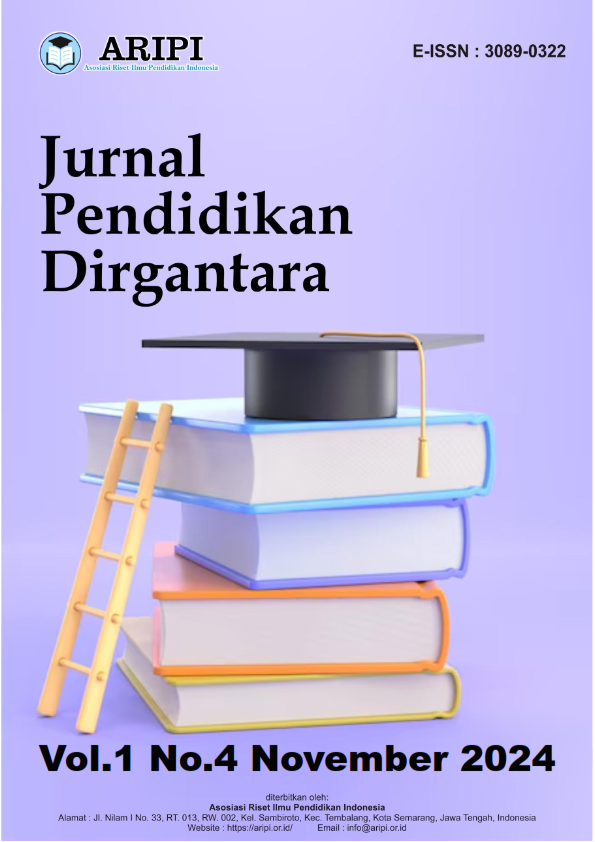Strategi Quantum Teaching untuk Meningkatkan Minat Belajar IPA Siswa Kelas IV di SDI Duarato
DOI:
https://doi.org/10.61132/jupendir.v1i4.190Keywords:
Interest in Learning, Quantum Teaching, Science LearningAbstract
The aim of this research is to determine the increase in interest in learning for fourth grade students in science subjects with the topic of discussing the characteristics of plants on Ceremai trees through the Quantum Teaching Learning Model at SDI Duarato for the 2024/2025 academic year. This type of research is Classroom Action Research (CAR). The subjects of this research were 15 grade IV students at SD Inpres Duarato, consisting of 8 male students and 7 female students. The object of this research is Natural Sciences (IPA) learning using the Quantum Teaching learning model. Based on research and data analysis, it can be concluded that the Quantum Teaching learning model can increase interest in learning science in class IV students at SD Inpres Duarato for the 2024/2025 academic year. This can be seen before implementing the Quantum Teaching learning model in science learning. Of the 15 students, 6 students (40%) completed it, and 9 students (60%) did not complete it. Furthermore, by applying the Quantum Teaching learning model, it was obtained that 9 students (60%) had completed their learning interest in cycle I, while 6 students (40%) had not completed it. In cycle II, 13 students (86.66%) completed it, and 2 students (13.33%) did not complete it. From the data above, there was an increase from the initial data, cycle I and cycle II.
References
Ahmad, S. (2016). Teori belajar dan pembelajaran. Prenada Media Group.
Arifin. (2018). Evaluasi ajaran (Cetakan ke-3). PT Remaja Rosdakarya.
Arikunto, S. (2013). Prosedur penelitian: Suatu pendekatan praktik. Rineka Cipta.
Asrid, D. N., & Sunarto. (2020). Faktor-faktor yang mempengaruhi terbentuknya konsep diri remaja (studi kualitatif pada siswa SMPN 6 Kota Madiun). Jurnal Konseling Gusjigang, 6(1).
Darman, R. A. (2020). Belajar dan pembelajaran. Guepedia.
Djaali. (2017). Psikologi pendidikan. PT Bumi Aksara.
Djamarah. (2015). Psikologi belajar. Rineka Cipta.
Fathurrohman, M. (2015). Model-model pembelajaran inovatif. Ar-Ruz Media.
Hidayat, R., & Abdillah. (2019). Ilmu pendidikan: Konsep teori dan aplikasinya. Lembaga Peduli Pengembangan Pendidikan Indonesia (LPPPI).
Hisbullah, S. P., & Selvi, N. (2018). Pembelajaran ilmu pengetahuan alam di sekolah dasar. Penerbit Aksara Timur.
Ismet. (2017). Seminar nasional pendidikan IPA. Aswaja Presindo.
Khairani. (2017). Psikologi belajar. Aswaja Presindo.
Kriyantono, R. (n.d.). Teknik praktis riset komunikasi kuantitatif dan kualitatif disertai contoh praktis skripsi, tesis, dan disertasi riset media, public relations, advertising, komunikasi organisasi, komunikasi pemasaran.
Lestari, & Mokhammad. (2015). Penelitian pendidikan matematika. Refika Adimata.
Maryadi, dkk. (2010). Pedoman penulisan skripsi FKIP. BP-FKIP UM.
Mulyasa. (2010). Menjadi guru profesional (menciptakan pembelajaran kreatif dan menyenangkan) (Cetakan Kesembilan). Rosda.
Rohmalina. (2018). Model pembelajaran Quantum Teaching untuk meningkatkan kompetensi guru PAUD. Klimedia.
Setiawan, D. (1999). Atlas tumbuhan obat Indonesia (Jilid I). Trubus Agriwidya.
Slameto. (2015). Belajar dan faktor-faktor yang mempengaruhinya. Rineka Cipta.
Sugiyono. (2016). Metode penelitian kuantitatif, kualitatif, dan kombinasi (mixed methods). Alfabeta.
Sulthon. (n.d.). Pembelajaran IPA yang efektif dan menyenangkan bagi siswa madrasah ibtidaiyah (MI). Elementary, 4, 47.
Tim Masmedia Buana Pustaka. (2016). Metode ringkas terpadu.




